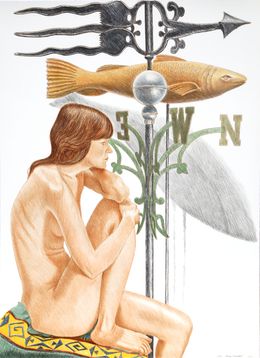
Nude Model with Banner and Fish Weathervanes
Philip Pearlstein
Print - 87.6 x 63.5 cm Print - 34.5 x 25 inch
$1,500
A key figure in the sharp-focus realist movement, he was a leader in the early 1960s of the revival of figure painting in America. He experimented briefly with landscapes and then concentrated on the realistic depiction of the nude figure, a traditional subject that had almost vanished from the contemporary art world. His work is characterized by a non-traditional informality, unexpected postures, and unusual perspectives including the radical cropping of figures. In his later works, he introduced rather elaborate backdrops including richly patterned fabrics and decorative floor patterns.
He was born and grew up in Pittsburgh and in 1944 enrolled at the Carnegie Institute of Technology. He spent three years in the Army and then returned to school, graduating in 1949 with a B.F.A. He pursued graduate studies in art history at New York University and received a Master's Degree in 1955.
During the 1950s Pearlstein exhibited abstract expressionist landscape paintings. Around 1958 he began to attend weekly figure drawing drawing sessions at the studio of Mercedes Matter. In 1961 Pearlstein began to make paintings of nude couples based upon his drawings, and in 1962 he began painting directly from the model in a less painterly and more realistic style. In so doing, he demonstrated that figurative realism could once again be made into a vital art form. In an article published in Arts Magazine in April, 1963, Sidney Tillim wrote that "[Pearlstein] has not only regained the figure for painting; he has put it behind the plane and in deep space without recourse to nostalgia (history) or fashion (new images of man) ... He paints the nude not as a symbol of beauty and pure form but as a human fact—implicitly imperfect".
Pearlstein's early landscape paintings—usually rock-strewn hillsides in which every angle, shadow, and shape was seen with a clinical clarity—foreshadow his treatment of the nude as a natural phenomenon devoid of any identity other than the attributes of sex and skin color. Before modernism, painting and sculpture presented the human body in every conceivable pose and situation sanctioned by history, religion, or mythology, but the twentieth century brought a new method of comprehending what we see as form for its own sake. In Pearlstein's paintings, the human body, placed in a corner of a floodlighted studio, assumes a new range of plastic realities, as the mass and weight of the body are emphasized in the unstudied character of the pose. The point of view frequently results in radical cropping of the figure at the edge of the canvas. The painting Models With Mirror is an example of Pearlstein's concern for the body as form.
Pearlstein's work is in over seventy museums collections in the United States, including the Art Institute of Chicago, The Cleveland Museum of Art, the Corcoran Gallery of Art, Hirshhorn Museum and Sculpture Garden, Kemper Museum of Contemporary Art, Metropolitan Museum of Art, The Museum of Modern Art and Whitney Museum of American Art amongst others. The Milwaukee Art Museum honored him with a retrospective exhibition in 1983 and accompanied the exhibition with a monograph on his complete paintings. He recently showed at the Century Association, New York; Frye Art Museum, Seattle; Galerie Haas, Zurich; and Galerie Haas & Fuchs, Berlin, Germany.
Since the mid-1950s Pearlstein has received several awards, most recently, the National Council of Arts Administrators Visual Artist Award; The Benjamin West Clinedinst Memorial Medal, The Artists Fellowship, Inc., New York, NY; and honorary doctorate degrees from Brooklyn College, NY, Center for Creative Studies and the College of Art & Design, Detroit, MI, and New York Academy of Arts, New York, NY. Pearlstein is a former President of the American Academy of Arts and Letters.
Although he briefly pursued Abstract Expressionism, he found his mature subject matter during the 1960s when he evolved his signature highly finished-hard edged, objective studies of the nude figure. He has earned awards from the American Academy and the National Institute of Arts and Letters.
After graduation, he was hired by Life Magazine to do page layouts, and was then awarded a Fulbright Hays fellowship, enabling him to return to Italy for a year, where he painted a series of landscapes. From 1959 to 1963, he was an instructor at Pratt Institute, in Brooklyn, NY, and subsequently spent a year as a Visiting Critic at Yale University in New Haven, CT. Finally, from 1963 to 1988, he was Professor, and then Distinguished Professor Emeritus at Brooklyn College, in Brooklyn, NY.
In 1988 he was elected into the National Academy of Design.

Print - 87.6 x 63.5 cm Print - 34.5 x 25 inch
$1,500
What are their 3 main works?
When was Philip Pearlstein born?